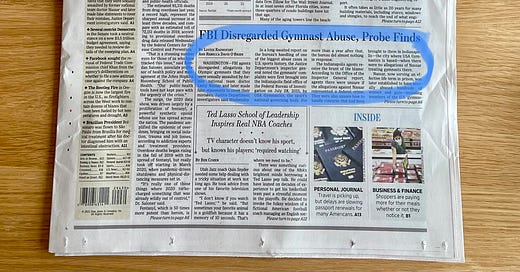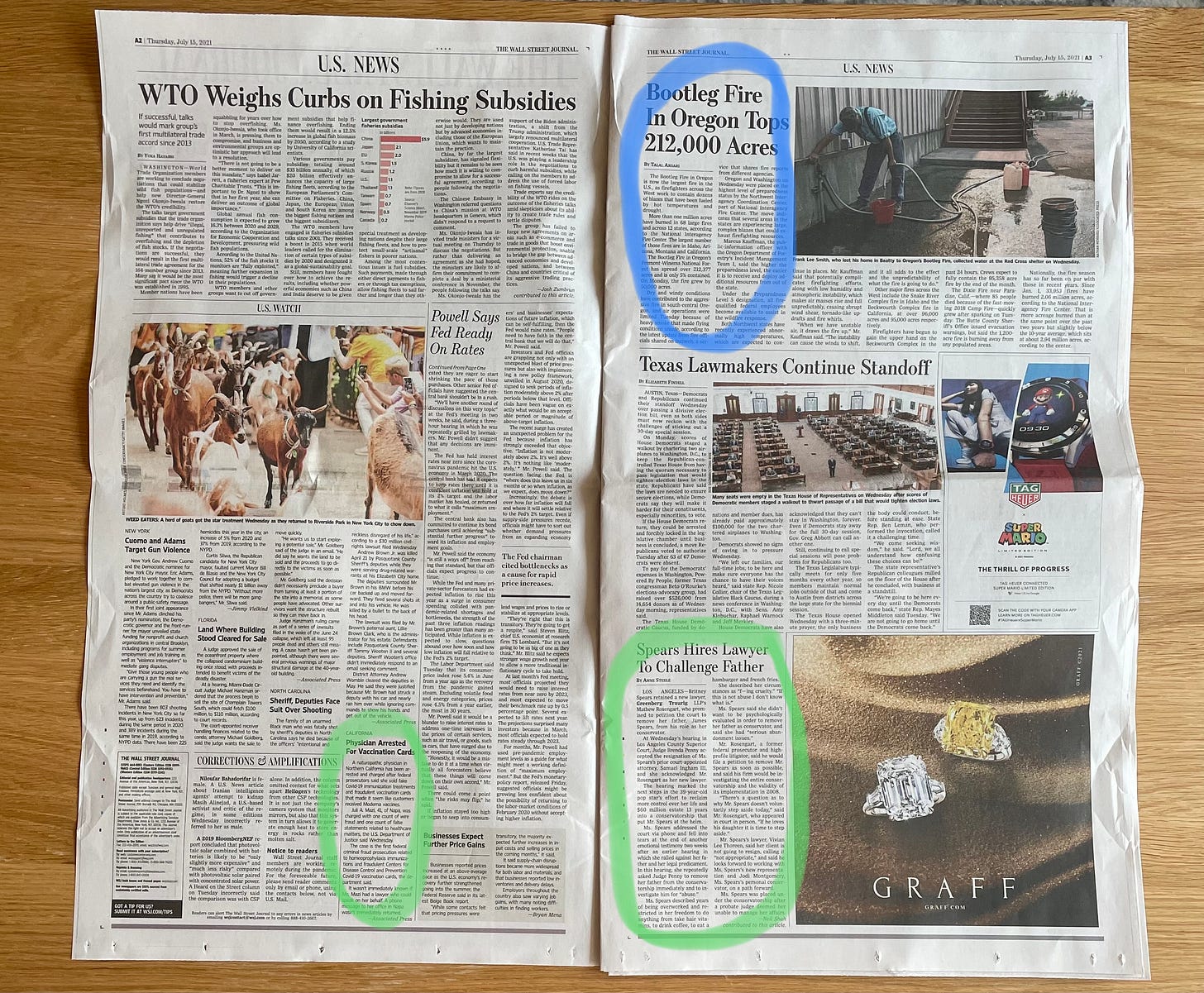Time Spent is a series of letters exploring how and why we should read the news, do care work and spend our time. Each letter includes tidbits from research, tips and experiments that are all part of a book I’m working on called Taking Back the News. If you’re new, subscribe here!
Good morning!
I’m back after a quarter-long break because I’ve been in deep work mode on the book proposal and also signed with a wonderful agent (hi Amy!) to get Taking Back the News into the editorial hands of someone great. It will be a long haul toward that day, but I’m finally freer to write you letters (and also I’m now supposed to build a “platform” as I write, help?)
So here’s what’s been on my mind this week.
About 8 years ago, I produced a video for Teachers College Record on a paper by the researcher Stephanie Jones, titled Teaching Bodies in Place, which has stayed with me ever since. Here's a link to the paper and you can see the abstract video embedded.
In it, Jones, who works in teacher education, finds that while her students truly believe that they are anti-racist, anti-classist teachers, when asked to spend time in communities where they will teach (“teaching bodies in place”) they discover more unconscious fear and discomfort than they could have anticipated.
I've been thinking about it a lot lately, because I think we underestimate the role that our body plays in processing information, be it the person in front of us, a news article or something on social media. And when place has been so limited for so long, what’s going on with our bodies?
What’s your body telling you about the news?
Ever since learning what a body scan is in therapy (scan your body from head to toe to bring awareness to what you might be feeling and where), I’ve started experimenting with it and other ways to check in with my body + emotions as I consume news.
For example, a few weeks ago, I sat myself down with the WSJ in print and asked myself how I felt as I scanned each headline. Here are the first few pages:
🟡 following, neutral
🔵 stressful or upsetting
🟢 invested, curious
🔴 flag for practical action
(see the rest on Instagram)
If such a brief package of stories (7 min total) can provoke this mix of emotions, how much more true is this when scrolling endlessly?
All that said, you can imagine how excited I was when Ezra Klein interviewed Annie Murphy Paul on his podcast this month.
Paul’s new book, The Extended Mind, just came out in June and here are some highlights from the conversation that made me feel way less crazy for doing my aforementioned news experiments.
How we encounter information matters
Paul’s book is based on a 1998 paper of the same name by philosophers Andy Clark and David Chalmers, which argues that cognition doesn’t take place entirely in the brain, but through a mix of neural, bodily and environmental processes.
Paul, who is a science writer, expands on that idea through the research that has come since to lay out how thought is shaped by our bodies, our physical environments and social exchange.
I haven’t gotten through the book yet, so I won’t summarize it but I did take some notes on the conversation with Klein (who read the book, had a colleague read the book and thoroughly discussed the discussion questions before talking to Paul, all of which is a good example of how cognition “loops” through a number of processes outside our brain).
First, a quote from the book that he opens with:
When fed a chunk of information, a computer processes it in the same way on each occasion, whether it’s been at work for five minutes or five hours, whether it is located in a fluorescent lit office or positioned next to a sunny window, whether it’s near other computers or is the only computer in the room. This is how computers operate. But the same doesn’t hold for human beings. The way we’re able to think about information is dramatically affected by the state we’re in when we encounter it.
Klein asks Paul why this is the case and she says it’s because contrary to popular belief, the brain is a biological and evolved organ that doesn’t actually work like a computer.
As we go through our day, she explains, we encounter far more information that we could ever consciously process or retain, so that information gets stored in our non-conscious mind. And even though we aren’t conscious of it, it shows up through our body (what scientists call interoception), through internal sensations like what you might experience as a “gut feeling” — your body is telling you, hey, we’ve been here before and we know how it went so this is the right thing to do now. But because we live in a world that is so brain-bound and cerebral, we tend to push those clues from the body aside and override them.
Instead, she argues, we should be cultivating that ability.
In fact, those of us who are more in touch with our internal sensations can make better use of the wisdom and experience stored in our body… which is not easy if you’ve grown up in a culture that teaches you to trust the cold, rational processes of your brain above all.
Getting better attuned to the body
So what happens if the body’s wisdom fails us? When Klein asked Paul this question, I immediately thought of the aforementioned teachers whose minds were trying to get them to overcome biases but bodies were slower to catch up.
Paul’s answer was simply that we need to become more skilled at determining when the body’s signals are steering us in the right direction, and one way to do that is by keeping an interoceptive journal, which is basically a log of how your body feels when you are contemplating decisions. Then, go back and review it to see if it was a successful decision or not. Patterns will emerge and you’ll overall be better attuned to your body and also be able to be more intentional with your decision-making.
I guess I’ve been doing my own weird version of an interoceptive news journal for a while, which returns us to my little newspaper exercise just a few days before I heard this conversation. After changing up my morning news routine enough times and noticing how I felt with each, patterns did click for me.
What my body told me doesn’t work: I have to protect my mornings from the anxiety and powerlessness that inevitably emerges from the headlines but I have been overriding this awareness for years. At the same time, completely ignoring news in traditional formats doesn’t work for me either (partly because of my profession, and partly because of FOMO), which I learned from experiments removing it entirely.
What does work: News, especially national/international is best introduced to my day after my creative energy is spent (so, the afternoon), OR when I am able to physically move during or immediately after consuming. Like walking+NPR or headlines+go out for coffee. Local and niche news I enjoy and doesn’t generally stress me out, so I keep it in my feeds and whenever works.
It could be different for you. I encourage you to find out. And if you need it:
✨ Here’s your permission to not read the news in the morning just because it arrives in the morning. And also to keep it out of spaces you want to protect, like your social feeds and/or your bed. ✨
But of course, those decisions are best arrived at after a bit of self-awareness :)
Experiments really matter
One of Paul’s goals with the book was to give people (and herself) alternatives to the reigning brain-bound model of working, which says that the “good student” or “good worker” is someone who sits there quietly until the work gets done. Instead, she said, we need to acquire a kind of second education that tells us how to use these outside the brain resources in a skillful way to bring in the right resource at the right time.
She’s not actually talking about the news, but for me, this directly falls into the missing elements of news literacy education, which would benefit from a greater understanding of our own behavior.
She says:
“I think we have to be really intentional and really skillful in the way that we use our devices to make sure that they are extending our minds in the way that they can, and not actually diminishing our thinking.”
And:
“If there’s one thing I’ve learned from reporting and researching psychology for 25 years, it’s that we don’t often know what’s best for us, and so we cling very firmly to these practices that don’t serve us. And it takes a kind of paradigm-changing new view to make us thing, oh, maybe it doesn’t have to be that way. Maybe the way we’ve been doing things isn’t so great.”
Side note: For those who don’t know me, some years ago, my dream was to open a news cafe: an eatery/bar that curated the day’s news across sources and thoughtfully prepared and presented them with food items in a way that honored the time or space they needed or didn’t need.
I didn’t end up doing it except for some project-based experiments (news salons, a redesign of the Starbucks at Teachers College to strategically place news around in different formats), but I did end up implementing that way of living into my own life.
For example, longform is nourishing and a lovely companion to cooking and laundry. Short documentaries are excellent dinner time choices but a bit too strong for bedtime. And so forth.
At risk of sounding like a broken record here, I think experiments really matter, especially to bring awareness to what is and isn’t working for us.
If you start to scan your body as you consume, tell me what you find out. It’s the best data to go on to start making small lifestyle modifications, much in the way we might with food.
And finally, talk to me!
In terms of the book, I’m opening a new research round right now, so if you’d like to talk about your own experience with news consumption, email me and I’ll send you a calendly link.
>>What to expect: It’ll be a 30 minute call in which we’ll explore the pains/pleasures of news consumption for you + I’ll run a few ideas by you :)
More next week!
Jihii
Time Spent is a series of letters exploring how and why we should read the news, do care work and spend our time. Each letter includes tidbits from research, tips and experiments that are all part of a book I’m working on called Taking Back the News. If you’re new, subscribe here!







